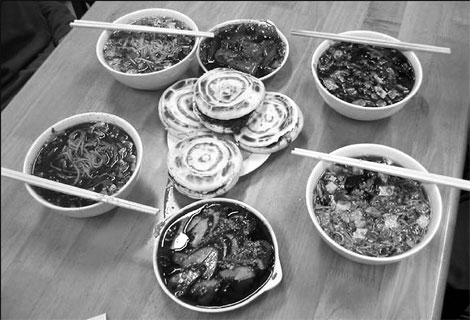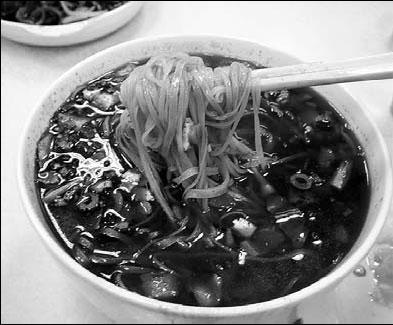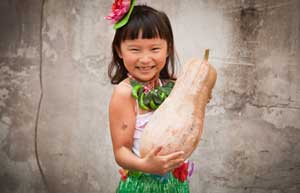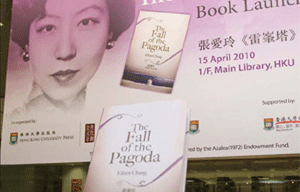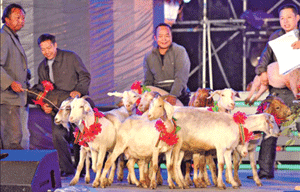Noodles with legends
Updated: 2011-10-04 07:56
By Yu Yilei and Ma Lie (China Daily)
|
|||||||||
|
Qishan noodles from Shaanxi are rightly famous, as much for their taste and texture as the communion of community and harmony that they represent. Photos by Ma Lie / China Daily |
Few in China are as passionate about their noodles as the natives from Xi'an. The noodles are steeped in folklore, family traditions and legends. Yu Yilei and Ma Lie share a few stories with us.
In China, novices unfamiliar with the food are often intimidated by strange names and even stranger customs. Take saliva noodles for example, a dish from Shaanxi in northwest China.
Unlike "saliva chicken", the Sichuan cold dish of steamed chicken bathed in chili oil and sauce, this does not mean drool inducing. It quite literally means that you are dipping into the same bowls, using recycled soup, sharing saliva.
This is actually a kind of Qi-shan noodles that is famous, or notorious, depending on how you see it - in which soup from the bowls of individual diners is returned to the pot and shared out in repeated servings.
Odd? No matter how off-putting it sounds, this is an accepted tradition to those of us born and bred in Xi'an, just a two-and-half-hour bus ride away from the place where the noodle dish originated.
And, although Shaanxi has numerous restaurants specializing in Qishan noodles everywhere, you will not find "saliva noodles" on the menu. The only way you can sample this is to be invited into the home on special occasions.
It was not until my parents and I were invited to such a noodle feast a couple of years ago that I fully appreciated the true meaning of such a meal - a communion of community and harmony.
"You should be happy if you are invited to have saliva noodles because the guests are limited to family members, close friends and special guests," my mom told me later.
The preparation itself involves the whole family, with helping hands from close neighbors and friends. After mixing wheat flour with water, the dough has to be kneaded for hours until it becomes glossy and shiny. It is then rolled out thin as paper and then cut into slivers of noodles.
When it comes to making the soup, it is just pure art.
First, five basic ingredients - carrots (red), beans (green), woo dear fungus (black), day lilies (yellow), and tofu (white) - are diced and then fried. Seasonings such as ginger, allspice, vinegar and red pepper are added. Another pot with tasty hot stock is prepared and after the fried diced ingredients are added, more salt, more vinegar and more red pepper goes in.
That's not all. A well-made saliva noodle must have "floating ingredients" such as strips of thin omelet, and a scattering or chopped spring onions.
How the noodles are served is what makes them so special. A small amount of boiled noodles is put into each diner's bowl, to be eaten in one mouthful. The soup left in the bowl goes back to the common pot and is ladled out for another serving. This is repeated until everyone is full, and then the soup in the bowl is drunk.
"I had 11 bowls. A personal record," my mom said jokingly. "It was a very interesting experience because the waiters - usually the young men of the family - were rushing between kitchen and tables serving the noodles."
But sadly, it will become harder and harder to take part in such a feast. Local officials are discouraging the tradition of saliva noodles anymore for "sanitary reasons". People were getting more affluent, they say, and should have better dietary habits.
The dish is disappearing, and so is the tradition, so if you are ever invited to a saliva noodle banquet, give it a chance and experience an unforgettable culinary experience.
Even out of the family home, Qishan noodles served in the shops are full of folklore. There are many legends connected to the dish, both of warm family bonds and the triumph of good over evil.
Legend has it that the noodles were also known as saozi mian. It was said that Zhou Wenwang (1152-1056 BC) was an orphan from an early age, and he was raised by his brother's wife. Once when he became ill in battle, his sister-in-law nursed him back to health by serving him piping hot noodles. He recovered soon after and named the dish saozi mian, or "my sister-in-law's noodles".
Yet another story says it was his son who popularized the noodles. There was a demon wreaking havoc in the region, and Zhou Wuwang, son of Zhou Wenwang, led a posse to kill the pest. They won, and used its meat to cook noodles with. It was delicious, they say, and the noodles became a favorite food.
Qishan noodles has nine outstanding features.
It is spicy and hot, with peppers fried in hot oil and added to the soup. It is savory, with a long list of ingredients of pork, lily, egg, mushroom, wood ear fungus, carrot, potato, beans, coriander, tofu, garlic, onions and ginger.
The noodles are thin, chewy and smooth. It is extremely hot as the soup is topped with boiling oil. It is served with generous amounts of soup and less noodles, and diners often eat several bowls at a seating. And, there is a lot of oil, forming a hot layer that keeps the noodles scalding hot even in winter.
The making of the dish was also used to test a new daughter-in-law's kitchen skills in rural Shaanxi.
On the second day of her marriage, she would have to show off her ability to make the chewy noodles and roll them out as thin as possible in front of her parents-in-law and other relatives. A new wife who could make very good noodles would win praise from her parents-in-law, husband and relatives.
You can contact the writers atyuyilei@chinadaily.com.cn andmalie@chinadaily.com.cn.
|
A small amount of boiled noodles is put into each diner's bowl, to be eaten in one mouthful. |
(China Daily 10/04/2011 page9)
